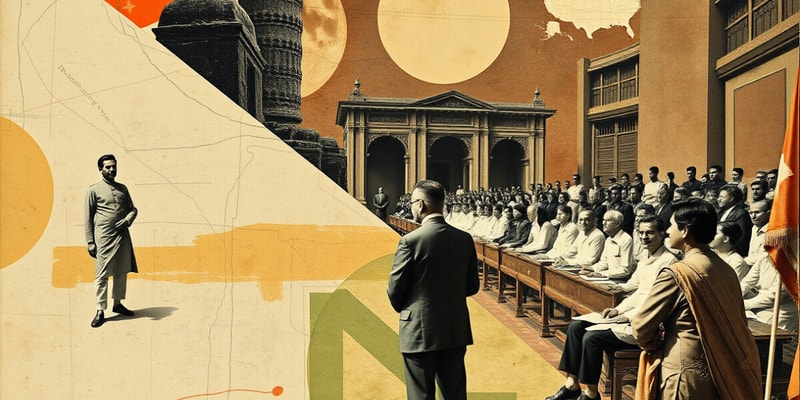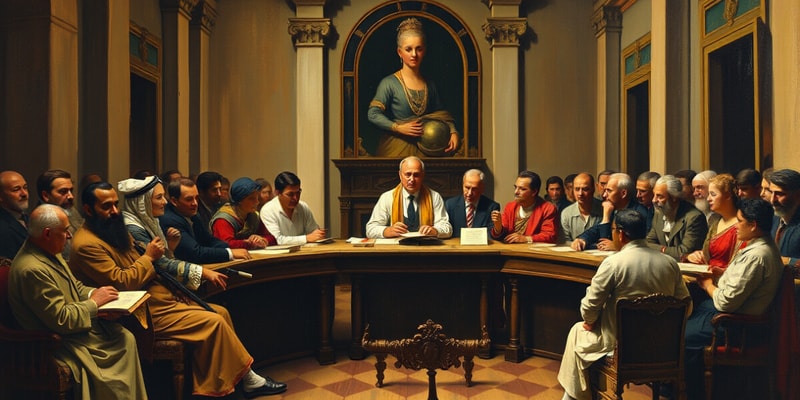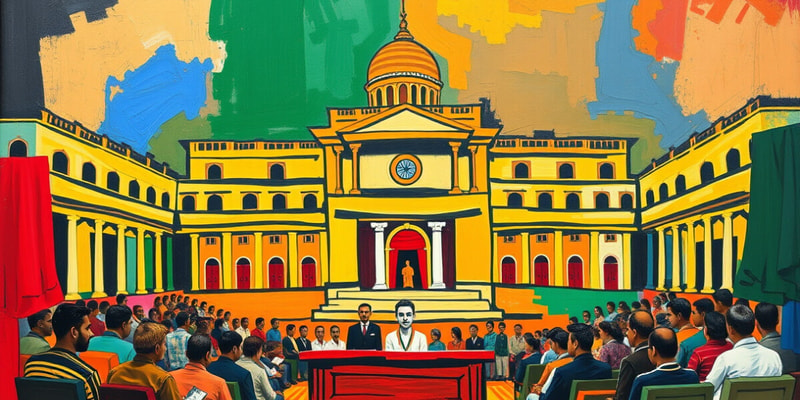Podcast Beta
Questions and Answers
What were the primary criticisms regarding the representation within the Constituent Assembly?
The Constituent Assembly was criticized for not being a representative body, as all members were not directly elected by the people through universal adult franchise.
How did the British Government influence the Constituent Assembly?
The Constituent Assembly was not a sovereign body and was shaped by proposals from the British Government, requiring permission for its sessions.
What is one distinctive feature of the Indian Constitution compared to others worldwide?
The Indian Constitution is the lengthiest written constitution in the world, showcasing a blend of rigidity and flexibility.
In what way did the structure of the Indian Constitution accommodate judicial authority?
Signup and view all the answers
Who played a significant role in drafting the Indian Constitution and how?
Signup and view all the answers
What geographical and historical factors contribute to the Indian Constitution being the longest written Constitution in the world?
Signup and view all the answers
How does the Indian Constitution exemplify a blend of rigidity and flexibility?
Signup and view all the answers
In what ways has the Indian Constitution drawn from various international sources?
Signup and view all the answers
What is the significance of the federal system with a unitary bias in the Indian Constitution?
Signup and view all the answers
Why are ordinary legislative matters included in the Indian Constitution that are typically left to ordinary legislation in other democracies?
Signup and view all the answers
Study Notes
Criticism of the Constituent Assembly
- Not a representative body; members were not directly elected based on universal adult franchise.
- Constituent Assembly was not sovereign; it operated under British Government proposals and permissions.
- Time-consuming process; the Indian Constituent Assembly took significantly longer than the American equivalent, which completed in four months.
- Dominated by the Indian National Congress, reflecting a lack of multi-party representation.
- Heavy lawyer-politician influence led to a complex and bulky Constitution.
- Predominantly upper caste Hindus were involved, challenging the ideal of India's diverse representation.
Key Figures and Symbols of the Assembly
- Elephant symbol (seal) was adopted by the Constituent Assembly.
- Sir B.N. Rau served as legal advisor to the Assembly.
- H.V. R. Iyengar acted as Secretary of the Constituent Assembly.
- S.N. Mukerjee was the chief draftsman of the Constitution.
- Prem Behari Narain Raizada was the calligrapher who beautifully handwrote the original Constitution.
Salient Features of the Constitution
- The Indian Constitution integrates diverse global constitutional features, tailored to suit the Indian context.
- Combines parliamentary sovereignty with judicial supremacy, ensuring a balanced governance structure.
Notable Characteristics
- Lengthiest written Constitution globally; initially consisted of 395 articles and has expanded to 465 articles divided into 25 parts and 12 schedules.
- Contains provisions for both fundamental governance principles and specific administrative guidelines.
- Geographical and historical diversity contributes to its length, influenced by the Government of India Act, 1935.
Rigidity and Flexibility
- The Indian Constitution features a blend of rigidity and flexibility, allowing amendments through:
- Special majority in Parliament.
- Ratification by half of the states with a simple majority.
- Some provisions can be amended by a simple majority, bypassing the more complex amendment process.
Sources of the Constitution
- Embodies elements from various constitutions, with significant influences noted:
- Structural foundation derived from the Government of India Act, 1935.
- Philosophical aspects draw from American and Irish Constitutions.
- Political features borrowed from the British Constitution.
Federal System with Unitary Bias
- Establishes a federal government structure, though the term 'Federation' is not explicitly mentioned within the Constitution.
- Features a dual government system, indicating a blend of federalism with unitary characteristics.
Studying That Suits You
Use AI to generate personalized quizzes and flashcards to suit your learning preferences.
Description
This quiz explores the various criticisms of the Indian Constituent Assembly. It discusses its lack of direct representation, limitations on its sovereignty, and the time it took to draft the constitution compared to other nations. Test your knowledge on the key issues surrounding the formation of the Indian Constitution.




